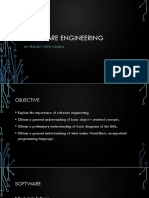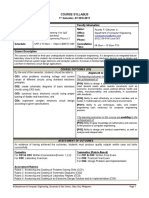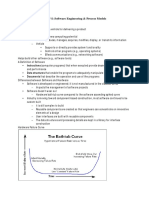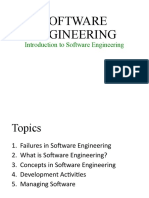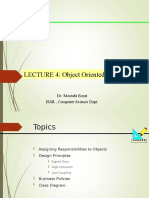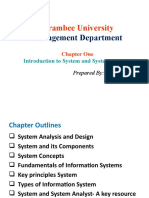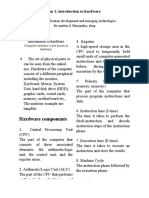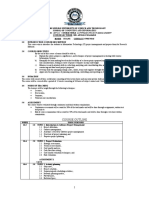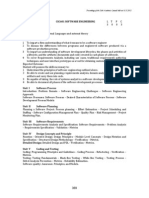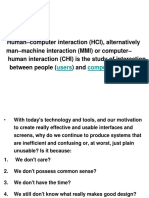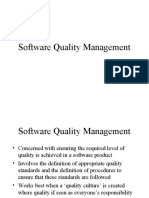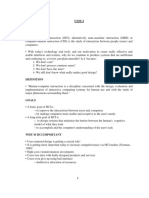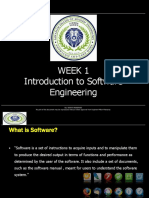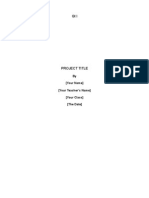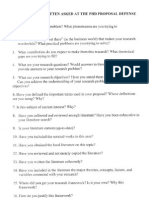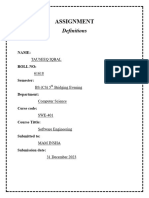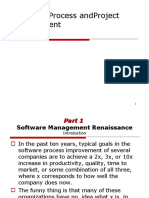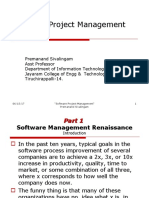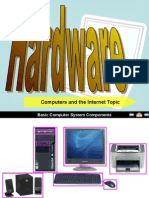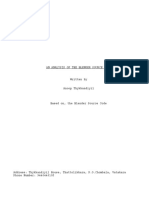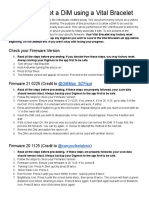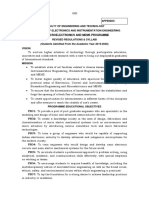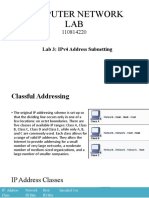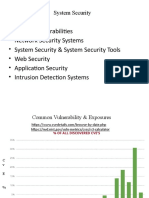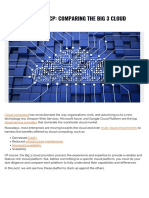Software Systems Development 10
Software Project
Organization and
Management
� Prerequisite: SSD9 Software
Specification, Testing, and
Maintenance (may be taken
concurrently).
Course textbook: Royce,Walker.
Software Project Management: A
Unified Framework. Reading, MA:
Addison Wesley Longman, Inc., 1998.
ISBN: 0-201-30958-0.
2
�The purpose of SSD10
1.Learn the organizational and management aspects of
software projects.
2.Learn project management techniques for scheduling,
costing, risk analysis, and project organization.
3.Learn to examine and objectively critique various kinds of
planning and management artifacts.
4.Learn to develop standard project management documents
and supplementary artifacts.
5.Learn a modern framework for managing the software
development process.
6.Learn to reason about software development models.
7.Learn principles concerning leadership, liability, intellectual
property, confidentiality issues, and management of customer
relationships.
4
�Hold Positions as Software
Project Managers
Those who certify in this course will be able to handle a
wide range of responsibilities that complex software
projects typically involve. These include:
a) development of iteration-based project plans and
schedules,
b) cost estimation and effort allocation,
c) management of customer relations,
d) risk assessment and mitigation,
e) communication with top management,
f) production of standards-based project documentation, and
g) interfacing with a legal department to deal with issues
involving confidentiality, intellectual property, patents, and
copyrights.
5
�Syllabus
Exercise
Exercise
Exercise
Exercise
Exercise
Exercise
Exercise
Exercise
Exercise
Exercise
Exercise
Exercise
Exercise
1 Thinking in the New Way
2 Life-Cycle Phases
3 Artifacts of the Process
4 Model-Based Software Architectures
5 Workflows of the Process
6 Checkpoints of the Process
7 Iterative Project Planning
8 Project Organization and Responsibilities
9 Process Automation
10 Tools (Gantt, PERT, and Resource Charts)
11 Project Control and Process Instrumentation
12 Tailoring the Process
13 Ethics
6
�Periods
1st attestation
2nd attestation
Final exam
Total
Tasks to complete
Exercise 1,
Exercise 2,
Exercise 3,
Exercise 4,
Exercise 5,
Exercise 6,
Exercise 7,
MCQ1, MCQ2, MCQ3,
MCQ4, MCQ5, MCQ6,
MCQ7, MCQ8, MCQ9,
Exam1 MCQ,
Exam1 PQ
Quizzes
Attendance
Exercise 8,
Exercise 9,
Exercise 10,
Exercise 11,
Exercise 12,
Exercise 13,
MCQ10, MCQ11, MCQ12,
MCQ13, MCQ14,
MCQ15, MCQ16, MCQ17,
MCQ18,
Exam2 MCQ,
Exam2 PQ,
Exam3 MCQ,
Exam3 PQ
Quizzes
Attendance
Certification Exam MultipleChoice
Certification Exam Practical
0,3*1stAtt+0,3*2ndAtt+0,4*F
Total
3
3
3
3
3
3
3
9
100
10
30
10
20
3
3
3
4
4
4
9
100
5
15
5
15
10
20
12
100
88
7
100
�Part 1
Software Management Renaissance
Introduction
In the past ten years, typical goals in the
software process improvement of several
companies are to achieve a 2x, 3x, or 10x
increase in productivity, quality, time to
market, or some combination of all three,
where x corresponds to how well the
company does now.
The funny thing is that many of these
organizations have no idea what x is, in
objective terms.
8
�Part 1
Software Management Renaissance
Table of Contents (1)
The Old Way (Conventional SPM)
The Waterfall Model
Conventional Software Management Performance
Evolution of Software Economics
Software Economics
Pragmatic Software Cost Estimation
�Part 1
Software Management Renaissance
Table of Contents (2)
Improving Software Economics
Reducing Software Product Size
Improving Software Processes
Improving Team Effectiveness
Improving Automation through Software Environments
Achieving Required Quality
Peer Inspections: A Pragmatic View
The Old Way and the New
The Principles of Conventional Software Engineering
The Principles of Modern Software Management
Transitioning to an Iterative Process
10
�11
�The Old Way
12
�Part 1
The Old Way
Software crisis
The best thing about software is its flexibility
It can be programmed to do almost anything.
The worst thing about software is also its flexibility
The almost anything characteristic has made it difficult to
plan, monitor, and control software development.
13
�14
�Part 1
The Old Way
The Waterfall Model
System
System
requirements
requirements
Software
Software
requirements
requirements
Analysis
Analysis
Drawbacks
Program
Program
design
design
Protracted integration
and late design breakage
Late risk resolution
Requirements - driven
functional decomposition
Adversarial stakeholder relationships
Focus on document
and review meetings
Coding
Coding
Testing
Testing
Maintenance
Maintenance
and
andreliance
reliance
15
�The Waterfall Model
16
�The Waterfall Model
17
�The Waterfall Model
18
�19
�Part 1
The Old Way
Conventional Software Management Performance
1.
2.
3.
4.
5.
6.
7.
8.
9.
Finding and fixing a software problem after delivery costs 100 times
more than finding and fixing the problem in early design phases.
You can compress software development schedules 25% of nominal,
but no more.
For every $1 you spend on development, you will spend $2 on
maintenance.
Software development and maintenance costs are primarily a
function of the number of source lines of code.
Variations among people account for the biggest differences in
software productivity.
The overall ratio of software to hardware costs is still growing. In
1955 it was 15:85; in 1985, 85:15.
Only about 15% of software development effort is devoted to
programming.
Walkthroughs catch 60% of the errors.
80% of the contribution comes from 20% of contributors.
20
�Part 1
Evolution of Software Economics
21
�22
�Part 1
Evolution of Software Economics
Most software cost models can be abstracted into
a function of five basic parameters:
Size (typically, number of source instructions)
Process (the ability of the process to avoid non-value-adding
activities)
Personnel (their experience with the computer science
issues and the applications domain issues of the project)
Environment (tools and techniques available to support
efficient software development and to automate process)
Quality (performance, reliability, adaptability)
23
�24
�Part 1
Evolution of Software Economics
Three generations of software economics
Cost
Software size
1960s-1970s
Waterfall model
Functional design
Diseconomy of scale
1980s-1990s
Process improvement
Encapsulation-based
Diseconomy of scale
2000 and on
Iterative development
Component- based
Return to investment
Environments/tools:
Custom
Size:
100% custom
Process:
Ad hoc
Environments/tools:
Off-the-shelf, separate
Size:
30%component-based, 70% custom
Process:
Repeatable
Environments/tools:
Off-the-shelf, integrated
Size:
70%component-based, 30% custom
Process:
Managed/measured
Typical project performance
Predictably bad
Always:
-Over budget
-Over schedule
Unpredictable
Infrequently:
-On budget
-On schedule
Predictable
Usually:
-On budget
-On schedule
25/112
�Part 1
Evolution of Software Economics
The predominant cost estimation process
Software manager,
software architecture manager,
software development manager,
software assessment manager
Cost modelers
Risks, options,
trade-offs,
alternatives
Cost estimate
26
�Part 1
Evolution of Software Economics
Pragmatic software cost estimation
A good estimate has the following attributes:
It is conceived and supported by the project manager,
architecture team, development team, and test team
accountable for performing the work.
It is accepted by all stakeholders as ambitious but
realizable.
It is based on a well defined software cost model with a
credible basis.
It is based on a database of relevant project experience
that includes similar processes, technologies,
environments, quality requirements, and people.
It is defined in enough detail so that its key risk areas
are understood and the probability of success is
objectively assessed.
27
�28
�Part 1
Improving Software Economics
Five basic parameters of the software cost
model:
1.Reducing the size or complexity of what needs to
be developed
2.Improving the development process
3.Using more-skilled personnel and better teams
(not necessarily the same thing)
4.Using better environments (tools to automate the
process)
5.Trading off or backing off on quality thresholds
29
�Part 1
Improving Software Economics
Important trends in improving software economics
Size
Abstraction and component
based development technologies
Process
Methods and techniques
Cost model parameters
Personnel
People factors
Environment
Automation technologies and tools
Quality
Performance, reliability, accuracy
Higher order languages
(C++, Java, Visual Basic, etc.)
Object-oriented
(Analysis, design, programming)
Reuse
Commercial components
Iterative development
Process maturity models
Architecture-first development
Acquisition reform
Trends
Training and personnel
skill development
Teamwork
Win-win cultures
Integrated tools
(Visual modeling, compiler, editor, etc)
Open systems
Hardware platform performance
Automation of coding, documents,
testing, analyses
Hardware platform performance
Demonstration-based assessment
30
Statistical quality control
�Part 1
Improving Software Economics
Reducing Software Product Size
The most significant way
to improve affordability and return on investment
is usually
Reuse,
object-oriented to produce a product that achieves
technology, automatic code
the
design
production,
and higher goals with the minimum amount of
order programming
human-generated source material.
languages are all focused
on achieving a given
system with fewer lines of
human-specified source
directives.
31
�Part 1
Improving Software Economics
Reducing Software Product Size - Languages
UFP -Universal Function Points
The basic units of the function points
are external user inputs,
external outputs,
internal logic data groups,
external data interfaces,
and external inquiries.
Language
SLOC per UFP
Assembly
320
128
Fortran 77
105
Cobol 85
91
Ada 83
71
C++
56
Ada 95
55
Java
55
Visual Basic
35
SLOC metrics
are useful estimators for software
after a candidate solution is formulated
and
an implementation language is known.
32/112
�Part 1
Improving Software Economics
Reducing Software Product Size Object-Oriented Methods
An object-oriented model of the problem and its solution encourages a
common vocabulary between the end users of a system and its
developers, thus creating a shared understanding of the problem being
solved.
Here is an example of how object-oriented technology permits
corresponding improvements in teamwork and interpersonal
communications.
The use of continuous integration creates opportunities to recognize risk
early and make incremental corrections without destabilizing the entire
development effort.
This aspect of object-oriented technology enables an architecture-first
process, in which integration is an early and continuous life-cycle activity.
An object-oriented architecture provides a clear separation of concerns
among disparate elements of a system, creating firewalls that prevent a
change in one part of the system from rending the fabric of the entire
architecture.
This feature of object-oriented technology is crucial to the supporting
languages and environments available to implement object-oriented
architectures.
33
�Part 1
Improving Software Economics
Reducing Software Product Size Reuse
1 Project Solution:
Many-project
solution: Operating
with high value per unit
investment, typical of
commercial products
Development Cost
and Schedule Resources
$N and M months
2 Project Solution:
50% more cost and
100% more time
5 Project Solution:
125% more cost and
150% more time
Number of Projects Using Reusable Components
34
�Part 1
Improving Software Economics
Reducing Software Product Size Commercial Components
APPROACH
ADVANTAGES
DISADVANTAGES
Commercial
components
Predictable license costs
Broadly used, mature technology
Available now
Dedicated support organization
Hardware/software independence
Rich in functionality
Frequent upgrades
Up-front license fees
Recurring maintenance fees
Dependency on vendor
Run-time efficiency sacrifices
Functionality constraints
Integration not always trivial
No control over upgrades and maintenance
Unnecessary features that consume extra resources
Often inadequate reliability and stability
Multiple-vendor incompatibility
Custom
development
Complete change freedom
Smaller, often simpler implementations
Often better performance
Control of development and
enhancement
Expensive, unpredictable development
Unpredictable availability date
Undefined maintenance model
Often immature and fragile
Single-platform dependency
Drain on expert resources
35/112
�36/112
�Part 1
Improving Software Economics
Improving Software Processes
Attributes
Metaprocess
Macroprocess
Microprocess
Subject
Line of business
Project
Iteration
Objectives
Line-of-business profitability
Competitiveness
Project profitability
Risk management
Project budget, schedule, quality
Resource management
Risk resolution
Milestone budget, schedule,
quality
Audience
Acquisition authorities, customers
Organizational management
Software project managers
Software engineers
Subproject managers
Software engineers
Metrics
Project predictability
Revenue, market share
On budget, on schedule
Major milestone success
Project scrap and rework
On budget, on schedule
Major milestone progress
Release/iteration scrap and
rework
Concerns
Bureaucracy vs. standardization
Quality vs. financial performance
Content vs. schedule
Time scales
6 to 12 months
1 to many years
1 to 6 months
Three levels of processes and their attributes
37/112
�38
�Part 1
Improving Software Economics
Improving Team Effectiveness (1)
The principle of top talent: Use better and fewer people.
The principle of job matching: Fit the task to the skills an
motivation of the people available.
The principle of career progression: An organization does
best in the long run by helping its people to selfactualize.
The principle of team balance: Select people who will
complement and harmonize with one another.
The principle of phase-out: Keeping a misfit on the team
doesnt benefit anyone.
39
�Part 1
Improving Software Economics
Improving Team Effectiveness (2)
Important Project Manager Skills:
Hiring skills. Few decisions are as important as hiring decisions. Placing the
right person in the right job seems obvious but is surprisingly hard to achieve.
Customer-interface skill. Avoiding adversarial relationships among stakeholders is a prerequisite for success.
Decision-making skill. The jillion books written about management have
failed to provide a clear definition of this attribute. We all know a good leader
when we run into one, and decision-making skill seems obvious despite its
intangible definition.
Team-building skill. Teamwork requires that a manager establish trust,
motivate progress, exploit eccentric prima donnas, transition average people
into top performers, eliminate misfits, and consolidate diverse opinions into a
team direction.
Selling skill. Successful project managers must sell all stakeholders (including
themselves) on decisions and priorities, sell candidates on job positions, sell
changes to the status quo in the face of resistance, and sell achievements
against objectives. In practice, selling requires continuous negotiation,
compromise, and empathy.
40
�Part 1
Improving Software Economics
Achieving Required Quality
Key practices that improve overall software quality:
Focusing on driving requirements and critical use cases early in the
life cycle, focusing on requirements completeness and traceability late
in the life cycle, and focusing throughout the life cycle on a balance
between requirements evolution, design evolution, and plan evolution
Using metrics and indicators to measure the progress and quality of
an architecture as it evolves from a high-level prototype into a fully
compliant product
Providing integrated life-cycle environments that support early and
continuous configuration control, change management, rigorous
design methods, document automation, and regression test
automation
Using visual modeling and higher level language that support
architectural control, abstraction, reliable programming, reuse, and
self-documentation
Early and continuous insight into performance issues through
demonstration-based evaluations
41
�Part 1
The Old Way and the New
42
�Part 1
The Old Way and the New
The Principles of Conventional Software Engineering
1.
2.
3.
4.
5.
6.
7.
8.
9.
10.
Make quality #1. Quality must be quantified and mechanism put into place to motivate its
achievement.
High-quality software is possible. Techniques that have been demonstrated to increase quality
include involving the customer, prototyping, simplifying design, conducting inspections, and hiring the
best people.
Give products to customers early. No matter how hard you try to learn users needs during the
requirements phase, the most effective way to determine real needs is to give users a product and let
them play with it.
Determine the problem before writing the requirements. When faced with what they believe is a
problem, most engineers rush to offer a solution. Before you try to solve a problem, be sure to explore all
the alternatives and dont be blinded by the obvious solution.
Evaluate design alternatives. After the requirements are agreed upon, you must examine a variety of
architectures and algorithms. You certainly do not want to use an architecture simply because it was
used in the requirements specification.
Use an appropriate process model. Each project must select a process that makes the most sense for
that project on the basis of corporate culture, willingness to take risks, application area, volatility of
requirements, and the extent to which requirements are well understood.
Use different languages for different phases. Our industrys eternal thirst for simple solutions to
complex problems has driven many to declare that the best development method is one that uses the
same notation through-out the life cycle. Why should software engineers use Ada for requirements,
design, and code unless Ada were optimal for all these phases?
Minimize intellectual distance. To minimize intellectual distance, the softwares structure should be as
close as possible to the real-world structure.
Put techniques before tools. An undisciplined software engineer with a tool becomes a dangerous,
undisciplined software engineer.
Get it right before you make it faster. It is far easier to make a working program run than it is to
make a fast program work. Dont worry about optimization during initial coding.
43
�Part 1
The Old Way and the New
The Principles of Conventional Software Engineering
11.
12.
13.
14.
15.
16.
17.
18.
19.
20.
Inspect code. Inspecting the detailed design and code is a much better way to find errors than testing.
Good management is more important than good technology. The best technology will not compensate for
poor management, and a good manager can produce great results even with meager resources. Good management
motivates people to do their best, but there are no universal right styles of management.
People are the key to success. Highly skilled people with appropriate experience, talent, and training are key. The
right people with insufficient tools, languages, and process will succeed. The wrong people with appropriate tools,
languages, and process will probably fail.
Follow with care. Just because everybody is doing something does not make it right for you. It may be right, but
you must carefully assess its applicability to your environment. Object orientation, measurement, reuse, process
improvement, CASE, prototyping-all these might increase quality, decrease cost, and increase user satisfaction. The
potential of such techniques is often oversold, and benefits are by no means guaranteed or universal.
Take responsibility. When a bridge collapses we ask, what did the engineers do wrong? Even when software fails,
we rarely ask this. The fact is that in any engineering discipline, the best methods can be used to produce awful
designs, and the most antiquated methods to produce elegant design.
Understand the customers priorities. It is possible the customer would tolerate 90% of the functionality
delivered late if they could have 10% of it on time.
The more they see, the more they need. The more functionality (or performance) you provide a user, the more
functionality (or performance) the user wants.
Plan to throw one away .One of the most important critical success factors is whether or not a product is entirely
new. Such brand-new applications, architectures, interfaces, or algorithms rarely work the first time.
Design for change. The architectures, components, and specification techniques you use must accommodate
change.
Design without documentation is not design. I have often heard software engineers say, I have finished the
design. All that is left is the documentation.
44
�Part 1
The Old Way and the New
The Principles of Conventional Software Engineering
21.
22.
23.
24.
25.
26.
27.
28.
29.
30.
Use tools, but be realistic. Software tools make their users more efficient.
Avoid tricks. Many programmers love to create programs with tricks- constructs that perform a
function correctly, but in an obscure way. Show the world how smart you are by avoiding tricky code.
Encapsulate. Information-hiding is a simple, proven concept that results in software that is easier to
test and much easier to maintain.
Use coupling and cohesion. Coupling and cohesion are the best ways to measure softwares
inherent maintainability and adaptability.
Use the McCabe complexity measure. Although there are many metrics available to report the
inherent complexity of software, none is as intuitive and easy to use as Tom McCabes.
Dont test your own software. Software developers should never be the primary testers of their
own software.
Analyze causes for errors. It is far more cost-effective to reduce the effect of an error by preventing
it than it is to find and fix it. One way to do this is to analyze the causes of errors as they are detected.
Realize that softwares entropy increases. Any software system that undergoes continuous
change will grow in complexity and become more and more disorganized.
People and time are not interchangeable. Measuring a project solely by person-months makes
little sense.
Expert excellence. Your employees will do much better if you have high expectations for them.
45
�Part 1
The Old Way and the New
The Principles of Modern Software Management
Architecture-first approach
The central design element
Design and integration first, then production and test
Iterative life-cycle process
The risk management element
Risk control through ever-increasing function, performance, quality
Component-based development
The technology element
Object-oriented methods, rigorous notations, visual modeling
Change management environment
The control element
Metrics, trends, process instrumentation
Round-trip engineering
The automation element
Complementary tools, integrated environments
46
�MCQ 1
1. Software development is unpredictable
because
(a) managers are very unpredictable
(b) software by its nature is highly flexible
(c) users are usually not fully cognizant of
their needs
(d) programmers are very unpredictable
47
�2. Which of the following statements are true of the 80/20 rule?
I. "Badly behaved" modules usually make up about 20 percent of
the total code but make up 80 percent of the scrap and rework
cost.
II. 20 percent of the people accomplish 80 percent of the
progress.
III. 20 percent of requirements account for 80 percent of
engineering effort.
(a) I, II, and III
(b) III only
(c) II and III only
(d) I only
48
�3. The waterfall model
(a) surfaces risk early
(b) allows you to correct early errors with
insights gained later on
(c) discourages functional decomposition
(d) focuses on documents and review meetings
49
�4. Which of the following statements are true of conventional
software project management performance?
I. Fixing software problems after delivery of the product is
relatively inexpensive.
II. Variations among people account for the biggest differences
in programmer productivity.
III. It worked best if 50 percent of the development effort was
devoted to programming.
(a) II only
(b) I, II, and III
(c) I only
(d) I and II only
50
�5. The success rate for software projects is very low
because
(a) software development is often a tedious and timeconsuming endeavor
(b) software development relies on antiquated processes
(c) project management has more to do with project
success than do programmers
(d) technology improvements are not used
51
�MCQ 2
1. A 10,000-line software solution will cost less per line
than a 100,000-line software solution because
(a) technical biases are less important on a big project
(b) the 100,000-line solution is a bad solution
(c) more bugs will be found in the 100,000-line solution
(d) communications overhead is less for a smaller team
52
�2. Function points
(a) are usually inferior to subjective cost estimates
(b) eliminate language differences in cost
estimation
(c) are easy for most organizations to learn
(d) are incompatible with most modern cost
models
53
�3.The five basic variables for software cost models are which of
the following?
(a) Complexity, number of contractors to employees, process,
CASE tools, and required quality
(b) Size, process, personnel, environment, and required
quality
(c) Size, process, personnel, CASE tools, and purchased
components
(d) Source lines of code, function points, methodology,
personnel, and quality
54
�4. Complexity arises from
(a) the increase in required communications as
teams become larger
(b) depending on only one person
(c) real time systems
(d) novel technology being introduced into the
process
55
�5. In modern practice, the automation of process is a first class
workflow and a focus of project management attention and
project resources because
(a) iterative development means each iteration will be
completely independent
(b) it allows areas of the life cycle to be improved that couldn't
be improved otherwise
(c) all software development activities and tools are
interrelated
(d) some tools have an extremely high payback
56
�6. Software environments without round-trip
engineering
(a) do not suffer much since early artifacts are rarely
referred to as a project enters later stages
(b) are less expensive
(c) reap the benefit of having simpler tools
(d) have difficulty keeping artifacts synchronized as
changes occur
57
�7. An advantage of commercial
components is that they
(a) are rich in functionality
(b) undergo frequent upgrades
(c) often have better performance
(d) can be purchased from any vendor
58
�8. Reducing size is best accomplished
through
(a) the use of Java or ADA
(b) object-oriented methods
(c) component-based development
(d) hardware investments
59
�9. An organization can make substantial
improvement through
(a) using more skilled personnel and better teams
(b) improving the development process
(c) balancing its attack across the five parameters
or drivers of the cost model
(d) just concentrating on size or complexity
60
�10. Hardware advances
(a) enable improvements in software technology
(b) allow use of commercially developed
components
(c) eliminate the need for software quality control
(d) eliminate the need for highly skilled personnel
61
�MCQ 3
1.Requirements creep can be addressed by
(a) demonstration-based review
(b) incremental releases
(c) component-based development
(d) early architecture performance feedback
Correct answer is (a)
Feedback: See section 4.2, page 66 in the
textbook.
62
�2. Intermediate releases in groups of usage
scenarios
(a) are only required for baselines
(b) have nothing to do with use cases
(c) eliminate the need for use cases
(d) demonstrate an evolving understanding
of system requirements
63
�3. Cost and schedule are impacted negatively
by
(a) adversarial stakeholders
(b) early breakage and scrap/rework
(c) fixed requirements
(d) inadequate function
64
�4. A demonstration-based approach
(a) makes architectural defects inevitable
(b) allows for early elimination of
architectural defects
(c) requires architectural defects to be
tolerated for early releases
(d) eliminates the need for a beta test
65
�5. Change-management environments
(a) are only important for baselines
(b) require objectively controlled baselines
(c) are too expensive for small projects
(d) rely on guidelines derived from the
experience of experts
66
�6. The architecture-first approach
(a) emerges from test results over a couple of "spirals"
(b) involves design and integration first, then
production and test
(c) involves metrics, trends, and process
instrumentation
(d) involves object-oriented methods, rigorous
notations, and visual modeling
67
�7. Conventional project risks
(a) only apply to the waterfall method
(b) have no impact on cost, quality, and
schedule
(c) are addressed through modern software
process principles
(d) no longer are of concern
68
�8. Model-based notation
(a) has little relationship to graphical design
methods
(b) is more objective than human review and
inspection of ad hoc design in paper documents
(c) eliminates textual notes
(d) eliminates need for human review
69
�9. Model-based development
(a) requires visual modeling and round-trip
engineering
(b) requires object-oriented methods and rigorous
notation
(c) requires complementary tools and integrated
environments
(d) requires visual modeling and risk control
70
�10. Attrition of key personnel can be addressed by
(a) a very structured environment
(b) successful early iterations and trustworthy
management
(c) hiring the best candidates
(d) giving most of the responsibility to a project's
average performers
71










